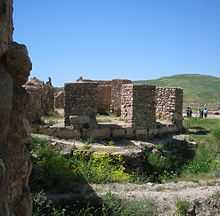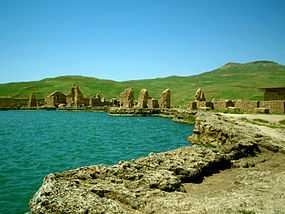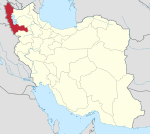Takht-e Soleymān
- For the similarly named locations see Takht-e Suleyman Massif in Iran and Sulayman Mountain near Osh, Kyrgyzstan.
| Takht-e Soleymān | |
|---|---|
| تخت سلیمان | |
|
The crater at Takht-e Soleymān | |
 Shown within Iran | |
| Location | West Azarbaijan, Iran |
| Coordinates | 36°36′11″N 47°14′09″E / 36.603171°N 47.235949°ECoordinates: 36°36′11″N 47°14′09″E / 36.603171°N 47.235949°E |
| Type | Settlement |
| Official name | Takht-e Soleyman |
| Type | Cultural |
| Criteria | i, ii, iii, iv, vi |
| Designated | 2003 (27th session) |
| Reference no. | 1077 |
| Region | Asia-Pacific |
Takht-e Soleymān (Persian: تخت سلیمان, Takht-e Soleymān, literally "the Throne of Solomon", in earlier ancient period known as Shiz or Adur Gushnasp,[1] literally "the Fire of the Warrior Kings") is an archaeological site in West Azarbaijan, Iran. It lies midway between Urmia and Hamadan, very near the present-day town of Takab, and 400 km (250 mi) west of Tehran.
The originally fortified site, which is located on a volcano crater rim, was recognized as a World Heritage Site in July 2003. The citadel includes the remains of a Zoroastrian fire temple built during the Sassanid period and partially rebuilt during the Ilkhanid period. This site got this Semitic name after the Arab conquest. This temple housed one of the three "Great Fires" or "Royal Fires" that Sassanid rulers humbled themselves before in order to ascend the throne. The fire at Takht-i Soleiman was called ādur Wishnāsp and was dedicated to the arteshtar or warrior class of the Sasanid.[2]
Folk legend relates that King Solomon used to imprison monsters inside the 100 m deep crater of the nearby Zendan-e Soleyman "Prison of Solomon". Another crater inside the fortification itself is filled with spring water; Solomon is said to have created a flowing pond that still exists today. Nevertheless, Solomon belongs to Semitic legends and therefore, the lore and namesake (Solomon's Throne) should have been formed following Arab conquest of Persia. A 4th century Armenian manuscript relating to Jesus and Zarathustra, and various historians of the Islamic period, mention this pond. The foundations of the fire temple around the pond is attributed to that legend.
Archaeological excavations have revealed traces of a 5th-century BC occupation during the Achaemenid period, as well as later Parthian settlements in the citadel. Coins belonging to the reign of Sassanid kings, and that of the Byzantine emperor Theodosius II (AD 408-450), have also been discovered there.
Gallery
-

-

-

-

-

-
Ruins of Takht-e-Soleyman's gate
See also
- Cities of the Ancient Near East
- Derbent - another Sassanid fortress in the World Heritage List
- Iranian architecture
- List of Iranian castles
- Sassanid Dynasty
References
- ↑ Huff, Dietrich (2002-07-20). "Taḵt-e Solaymān". Encyclopædia Iranica. Retrieved 2013-06-11.
- ↑ Zakeri, Mohsen. Sasanid soldiers in early Muslim society: The origins of Ayyaran and Futuwwa. Harrassowitz Verlag. p. 32. ISBN 3-447-03652-4.
External links
| Wikimedia Commons has media related to Takht-i-Suleiman. |
- Takhtesoleiman.ir, Official Website
- Unesco.org, Takht-e Soleyman - UNESCO World Heritage Site
- Opera.com, image from Takht-e suleiman
- Irannegah.com, Video from Takht-e Soleyman
- More pictures, Tishineh
| ||||||||
| ||||||||||||||||||||||||||||||||||
| |||||||||||||||||||||||||


